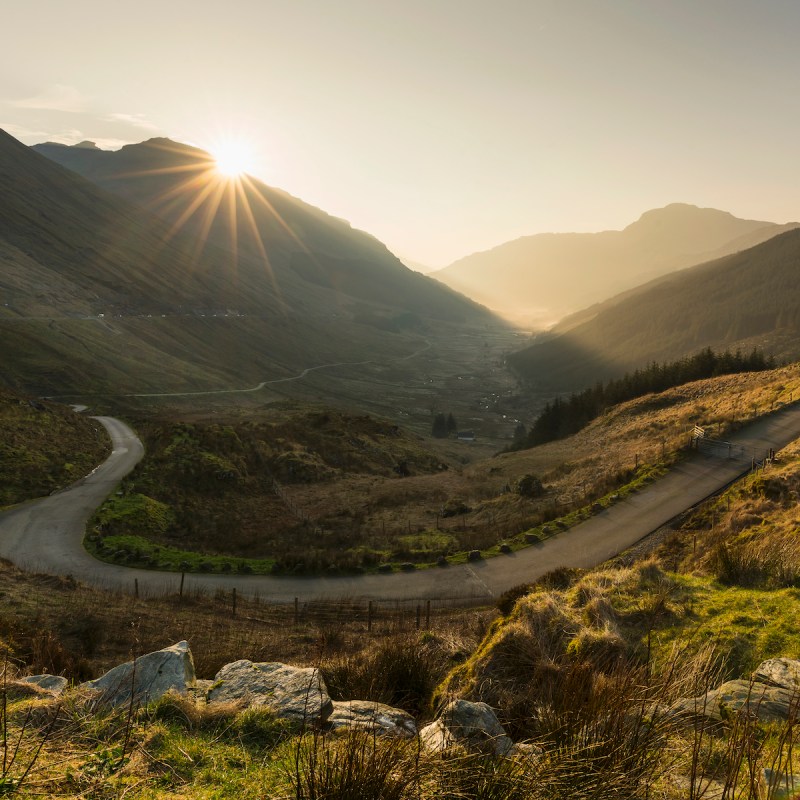
The Scottish Highlands offer up-close nature, wild and majestic scenery around many corners, history, and adventure. It is where golf was invented, and the national animal is the unicorn. What more do you need for a perfect holiday?
Videos by TravelAwaits
For Scotland’s New Year’s Eve festival, Hogmanay, we hired a car and driver (you can take day trips), headed north to tour the Highlands, and learned why winter is the perfect time to visit. Like us, 8.3 percent of Americans claim Scottish heritage. While you can learn a lot about your family’s clans in Edinburgh and Stirling Castles, getting out into the countryside allows you to gain a love of the land beyond the city experience. Inverness is a logical place to start.
Pro Tip: Be prepared for Scotland’s variable and unpredictable weather. The Scots like to say, “You can experience all four seasons in a day.” Thick socks, hats, and layers of warm, waterproof gear remain a must when traveling in winter, as does an appropriate water and food supply.
Here are seven great reasons that show winter is a perfect time to visit Scotland.

1. Fewer Crowds
The British Isles are typically crowded. Traveling off-season is the perfect time to explore with space to spare. After passing over the Firth of Forth, enjoy the scenery and start in Inverness with shopping, Inverness Castle, Urquhart Castle and Visitor Center, and Loch Ness to seek out “Nessie,” the Loch Ness Monster.
From Inverness, you can choose to go north to the Isle of Skye and over 900 islands, or return south towards Fort William, Oban, and the “Bonny, Bonny Banks of Loch Lomond.” In between, stop to visit the Outlander exterior film locations. This is the perfect weather to recreate a photo of Claire traversing the standing stones at Craigh na Dun.

Winter in Scotland is, in fact, an excellent time to take photographs. From recreations of looks from your favorite films and shows (Outlander, Harry Potter, Brigadoon, Skyfall, Disney’s Brave, and The Crown) to stunning wintry landscapes, be sure to have your camera ready.
Visit Scotland’s six UNESCO World Heritage sites outside Edinburgh, including the Stones of Stenness — standing stones in the Orkney Islands that predate Stonehenge by hundreds of years.
Drive over the Skye bridge to the Isle of Skye and check out The Fairy Glen, Fairy Pools, or Dunvegan Castle. With reduced crowds come reduced prices at some historic homes that make your visit that much more memorable. Take an abbreviated Castle Tour or drive along North Route 500, depending on schedule and weather.
Fort William
But when you stick to the Highlands, you’ll want to wander around Fort William and visit Old Inverlochy Castle, or Neptune’s Staircase, the longest staircase lock in Britain. Have your camera ready for a glimpse of the Jacobite Steam Train billowing across the aqueduct. If you can make the time, it’s worth it to hop on.
Oban
In Oban, take a walking tour or wander after enjoying the country’s famous fish ‘n chips at Nories. Then, climb the hill to McCaig’s Tower, the “Crown of Oban,” on historic Battery Hill. This half-circle stone lime wall was built to employ stonemasons during economic downturns and was never used during battle. The location, though, provides excellent panoramic views over Oban, neighboring islands, and the deep, cold waters of the Firth of Lorn.

2. Winter Festivals
On November 30, Scotland celebrates St. Andrew’s Day, the patron saint of Scotland. Locals and visitors alike celebrate with dance, dinner, and cultural displays.
Hogmanay kicks off the New Year in style. While the largest festival remains in Edinburgh, most towns and cities host their own. Loch Ness invites you to follow their social pages to keep up with the party.
Our favorite part of Hogmanay was the torch bearers’ ceremony where each party lit a torch and carried it along a serpentine path in Old City. With music, art, literature, and history alive and well in the statues and actors amongst you, it’s a grand night.
January 25 is Robert Burns Night in honor of Scotland’s national poet. Enjoy your haggis, whisky, and ceilidh dancing, and plan to sleep in the next day.

3. Warm Up With Whisky
Taste the so-called “Water of Life!” Eat, drink, and be merry at local distilleries where you’ll hear the history of whisky-making as the aroma of the malt, or perhaps the angel’s share, fills the space. Find elbow room at local pubs during the long winter nights. Your older teens may be pleased to learn the minimum age for drinking in Scotland is 18.
Choose from 100 distilleries across five whisky regions and learn about the reasons for distinct tastes, from the original recipe to the barrels that age the batch. Enjoy a dram, or two, and the companionship of locals who can regale you with local legends and folklore.
4. A Great Time To Golf
For many tourists, Scotland is synonymous with golf, specifically St. Andrews Links. Located on the east Scottish coastline’s sand dunes, the weather in St. Andrews can change in minutes but they’ve accommodated for that with firm, fast-draining turf that makes the course one of the best in the world year-round. With four courses open through the winter, determined golfers ward off the cold to make the most of their time on the legendary Old Course or its compatriots, Jubilee, Strathtyrum, and New Course.
Bonus for these hardy souls: It’s half the price to golf in winter as it is in summer.
During your non-golf-playing time, you may enjoy a Golf History Tour, and for the non-golfers, a walking tour that includes Scotland’s oldest university.
Pro Tip: Reservations to play at St. Andrews are required and fill quickly, so book early.

5. Unforgettable Stargazing (And The Northern Lights)
When Scotland’s night skies are clear, the sparkling celestial activity is spectacular. If you’re lucky, you’ll be here when the aurora borealis is active. The further north you are, the more likely you are to see the lights, especially away from town light pollution.
The rugged snow-capped mountains and lovely lochs or beaches make excellent backdrops for the northern lights.
Pro Tip: Download the aurora forecast app before you go.
Our favorite place to stay is Cameron House with its beautiful location and wonderful spa on Loch Lomond. Its light pollution remains low and offers excellent stargazing with clear skies.

6. Hike From Sand To Snow
From the snow-dusted mountain peaks of winter to the craggy shoreline and white sand beaches, as long as you dress properly for the weather and take provisions, winter is a beautiful time to hike through the highlands with walks for all levels.
The unmissable, must-do event in Inverness is viewing Loch Ness from Urquhart Castle.
In Fort William, the must-do for climbers is hiking Ben Nevis, the U.K.’s tallest mountain. The summit panorama includes Scottish Highland lochs and mountains as far as you can see; on a clear day, that’s about 150 miles, sometimes reaching the Irish coast. At 4,411 feet, it’s an 8-hour climb, and many expert climbers pitch a tent for the night to enjoy the breathtaking sunset.
For a less strenuous jaunt, walk to Steall Falls and enjoy the sounds of rushing water before you spot the waterfall. You may recognize this moss-covered area as the setting for a Quidditch match in Harry Potter.
Loch Lomond
In Loch Lomond, visit the viewpoint at Rest and Be Thankful. If you dress warm enough, enjoy a picnic lunch here as you commune with nature. One thing you’ll quickly learn about Scotland is that they offer some of the best hot chocolate — with whipped cream, marshmallows, or both! Ask your hotel for a thermos to take with you for your outdoor adventures.

7. Skiing
Scotland’s five ski resorts vary from excellent beginner learning facilities to serious back-mountain slopes. Glencoe Mountain, aka “White Corries,” is the oldest and contains the gnarliest black-diamond run in Scotland, called “the Flypaper.”
Glenshee Ski Centre spans three valleys and caters to families with great beginner and intermediate runs. It is known for its challenging black run, “The Tiger.” The Nevis Range is the newest and offers spectacular views of Loch Eil and Ben Nevis from Scotland’s only mountain gondola. Their back-mountain runs are meant only for experts.

The CairnGorm Mountain resort is Scotland’s most popular, with reliable snow and plenty to do in case of bad-weather days. Lecht Ski Centre caters to families and is known to have the best beginner slopes and facilities in Scotland.
And one of the most beneficial elements of traveling to Scotland in winter? No midges!
For more on the Scottish Highlands, check out these articles:
